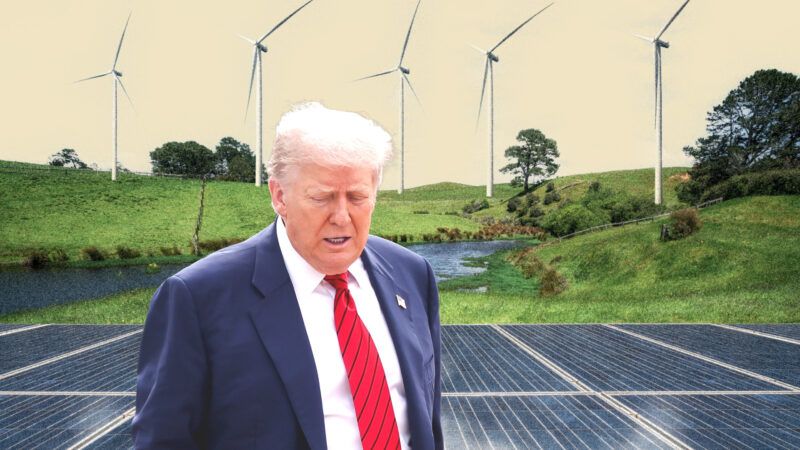The Trump Administration's Move To Halt Wind and Solar Development on Federal Lands Reverses a Biden Priority
Reducing the government’s ownership of federal lands is the best way to protect against this energy policy whiplash.

On Friday, Interior Secretary Doug Burgum issued a secretarial order that could effectively prohibit his agency from issuing permits for wind and solar on federal lands unless they produce as much energy per acre as fossil fuels or nuclear power, reports Heatmap News. Specifically, the order directs the Interior Department to consider "a reasonable range of alternatives that includes projects with capacity densities meeting or exceeding that of the proposed project," when conducting a review under the National Environmental Policy Act.
"Based on common sense, arithmetic, and physics, wind and solar projects are highly inefficient uses of Federal lands," the order reads. "On a technology-neutral basis, wind and solar projects use disproportionate Federal lands relative to their energy generation when compared to other energy sources, like nuclear, gas, and coal."
On one hand, the announcement could signal a return to sound energy policy. Under former President Joe Biden, the federal government paused new oil and gas leasing (eventually lifting the ban) and supercharged renewable energy development on federal lands. Political favoritism of green energy sources, which run at full power less than 40 percent of the time and need more land to produce a megawatt of electricity than other conventional sources, coupled with the retirement of baseload energy sources, has undermined the outlook of the U.S. electricity grid, according to the Energy Department.
However, the Trump administration is trading Biden-era energy favoritism for its own. The order says in no uncertain terms that laws governing federal land management call into question "whether the use of Federal lands for any wind and solar projects is consistent with the law, given these projects' encumbrance on other land uses, as well as their disproportionate land use when reasonable project alternatives with higher capacity densities are technically and economically feasible."
The order is not surprising given President Donald Trump's animosity toward renewable energy sources since being reelected. In January, the Interior Department issued a 60-day pause on all renewable energy leasing on federal lands, and last week, the Bureau of Ocean Energy Management closed off 3.5 million acres of offshore waters that had been designated as suitable for wind energy development. In July, Burgum directed his agency to review its policies and end those that give preferential treatment to wind and solar. This order was given in response to an executive order signed by Trump to end "market distorting subsidies for unreliable, foreign controlled energy sources."
At the same time, the Trump administration has moved to streamline the deployment of other energy sources, including coal, which developers and markets are moving away from. The One Big Beautiful Bill Act, signed into law in July, mandates at least 4 million additional acres of federal land to be opened up for coal mining, explains the Institute for Energy Research. The president has also called coal "beautiful," as his administration has fast-tracked permits for coal mines.
A president using the federal government's management of lands to influence national energy policy is not uncommon, but it does highlight a larger issue of the government owning too much land. The federal government is the nation's largest landowner, controlling roughly one-third of all the land in the United States. Public lands are also responsible for a significant share of oil and gas production—a share that has increased in recent years as more companies have increased drilling activities and operations, according to the Energy Information Administration. This large swath of ownership has allowed presidents from Barack Obama to Donald Trump to use the far-reaching power of the government to reward and punish energy sources as they see fit.
In June, Sen. Mike Lee (R–Utah) attempted to decouple the government from land management by authoring an amendment to the Big Beautiful Bill Act, requiring the federal government to sell 0.42 percent to 0.63 percent of all the public land it manages. While the amendment was shot down by the Senate parliamentarian, "the problem with [the] public lands proposal," wrote Reason's Christian Britschgi, was "that it [didn't] sell off enough land."
At the end of the day, Burgum's order may not have a significant effect on renewable energy development. Federal lands are only responsible for about 4 percent of the nation's renewable energy generation and, as of January 17, only 48 renewable energy projects comprising a little over 500,000 acres are undergoing review by the Bureau of Land Management. (Compare this to the 32,000 acres of oil and gas leases across over 22 million acres awarded by the agency in FY 2024.)
Still, the announcement does further solidify the Trump administration's position on renewable energy sources and its willingness to use the federal government's management of lands to accomplish its goals—which hurts consumers and America's energy competitiveness.


Show Comments (38)